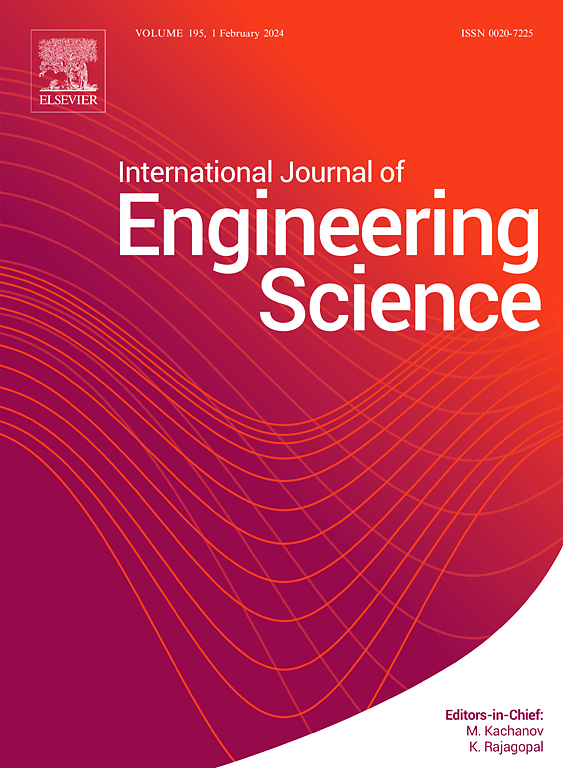热超材料尺寸相关热膨胀系数的表面取向均质化方法
IF 5.7
1区 工程技术
Q1 ENGINEERING, MULTIDISCIPLINARY
International Journal of Engineering Science
Pub Date : 2025-03-23
DOI:10.1016/j.ijengsci.2025.104248
引用次数: 0
摘要
本文探讨了微观结构对热超材料有效热膨胀系数的影响,强调了表面诱导的尺寸依赖效应。这些效应源于独特的孔隙微观结构特征,受体积分数和几何构型的影响。与纳米级声子驱动的表面效应不同,综合有限元数值模拟揭示了热超材料的宏观表面机制是由微观结构特征引起的热传导途径的变化引起的。这些表面区域的特征是固有长度,由微观结构本身决定。为了准确地捕获线性热膨胀的复杂尺寸相关系数,我们开发了一种面向表面的均匀化方法,利用表面机制下外在和内在长度之间的相互作用。与传统的均质化方法不同,这种方法不需要遵守尺度分离原理。通过对温度变化下的热超材料薄片的模拟,验证了该方法的有效性,突出表明该方法结合了传统均匀化方法的效率和高保真有限元方法的高精度。本文不仅提供了一种新的面向表面的均匀化方法,克服了热超材料结构的计算难题,而且还提供了一种构建离线本征长度数据集的方法,有利于指导热超材料结构的数据驱动设计。本文章由计算机程序翻译,如有差异,请以英文原文为准。
Surface-oriented homogenization method for size-dependent thermal expansion coefficient of thermal metamaterial
This paper explores the influence of microstructures on the effective thermal expansion coefficient of thermal metamaterials, highlighting the surface-induced size-dependent effects. These effects stem from the unique porous microstructural characteristics, influenced by volume fraction and geometric configuration. Unlike nanoscale phonon-driven surface effects, comprehensive finite element numerical simulations reveal that macroscopic surface mechanisms in thermal metamaterials arise from changes in heat conduction pathways due to microstructural features. These surface regions, characterized by an intrinsic length, are determined by the microstructure itself. To accurately capture the complex size-dependent coefficients of linear thermal expansion, we developed a surface-oriented homogenization method that leverages the interaction between extrinsic and intrinsic length under surface mechanisms. Unlike classical homogenization methods, this approach does not require compliance with the principle of scale separation. The effectiveness of this surface-oriented homogenization method is demonstrated through simulations of thermal metamaterial sheet subjected to temperature variations, highlighting that this method combines the efficiency of traditional homogenization methods with the high accuracy of high-fidelity finite element methods. This paper not only provides a novel surface-oriented homogenization approach that can overcome computational challenges of thermal metamaterial structures but also offers an approach to constructing an offline dataset for the intrinsic length that is beneficial to guiding the data-driven design of thermal metamaterial structures.
求助全文
通过发布文献求助,成功后即可免费获取论文全文。
去求助
来源期刊

International Journal of Engineering Science
工程技术-工程:综合
CiteScore
11.80
自引率
16.70%
发文量
86
审稿时长
45 days
期刊介绍:
The International Journal of Engineering Science is not limited to a specific aspect of science and engineering but is instead devoted to a wide range of subfields in the engineering sciences. While it encourages a broad spectrum of contribution in the engineering sciences, its core interest lies in issues concerning material modeling and response. Articles of interdisciplinary nature are particularly welcome.
The primary goal of the new editors is to maintain high quality of publications. There will be a commitment to expediting the time taken for the publication of the papers. The articles that are sent for reviews will have names of the authors deleted with a view towards enhancing the objectivity and fairness of the review process.
Articles that are devoted to the purely mathematical aspects without a discussion of the physical implications of the results or the consideration of specific examples are discouraged. Articles concerning material science should not be limited merely to a description and recording of observations but should contain theoretical or quantitative discussion of the results.
 求助内容:
求助内容: 应助结果提醒方式:
应助结果提醒方式:


